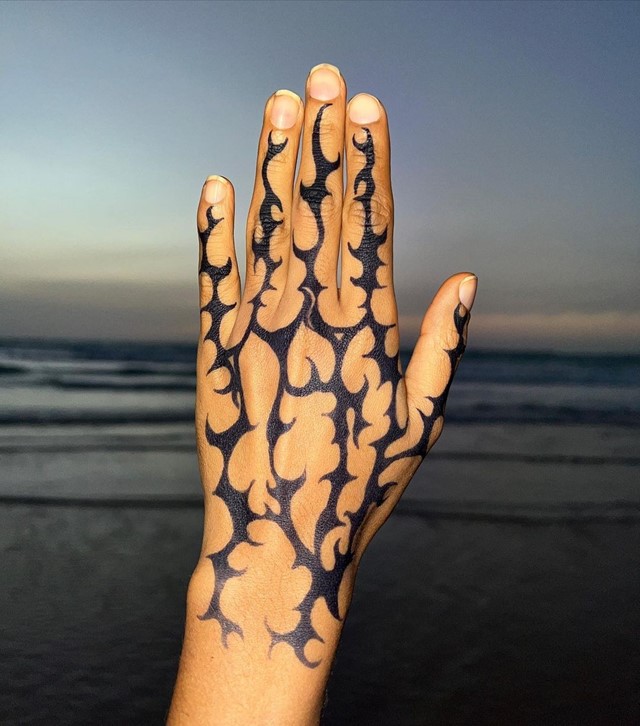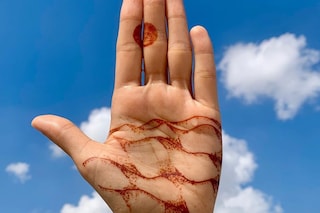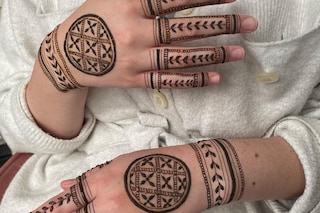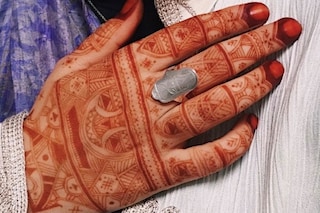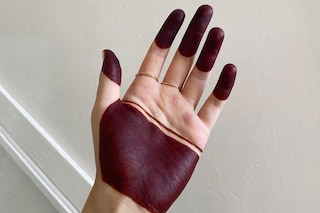Young henna artists are moving away from traditional floral designs, creating art that’s more relevant for day-to-day life
It’s the day before Eid, and a small makeshift henna parlour is taking form in the dining room. The family henna artist, my sister, is in the middle of a circle of stretched arms. Fingers wiggling, arms flapping, it’s chaotic to the unfamiliar eye. But to us, it’s nothing out of the ordinary, a seasoned ritual to bring in the beginning of a celebration, steeped in intricate tales of belonging.
While a common consensus on its origins is yet to be agreed on, some historians report the earliest use of henna as a part of the mummification ritual among the Ancient Egyptians, and by Cleopatra herself to adorn her body. Today, the art form is practised across the globe, from Sudan to India. In its functionality, henna is simple: it’s an act of expression and celebration, done for events like weddings and religious festivities.
There are a few hard and fast rules of henna practice, but for the most part, it’s free-flowing and follows the artistic genius of generations before. The fluidity of henna brings about varying design styles: the henna style of Dubai would be different to that of Pakistan, for example. Each design is a specific exploration of identity and delicate embrace of community, of tales from long before.
Today, the next generation of henna artists are imagining a new world of henna and embracing modern ways of being beyond – but not removed from – its traditional practice. Chiropractor-turned-designer and artist Azra Khamissa is part of this wave. For Khamissa, the premise of henna remains the same, it’s a practice to connect individuals, and it’s in the style where she has been inspired by change. Her bold creations are far from the floral grandeur designs traditionally associated with henna.
It began with a friend’s henna party where Khamissa searched for a design to suit her aesthetic, but couldn’t find anything that felt right. Instead, she ended up drawing inspiration from stripped-back tribal designs, “a traditional circle in the centre and my fingertips,” she says. Since then, her fresh, minimal and deliberate take on henna has started a mini-revolution among henna wearers, and she now has over 160,000 followers on Instagram. People who weren’t fans of the customary feminine floral designs now have a way to reconnect with a part of their identity through traditional practice. “The stripped-back nature of her designs meant I too was able to join in the celebration and feel part of my own community, it suited my style so much more,” Sabira Akhtar tells Dazed.
While these dreamy and contemporary designs offer something new, they don’t take away from what came before. For Khamissa, the use of henna is part of something bigger, it’s a way to highlight, appreciate, respect and revive her culture and traditions. “Some of them are so beautiful but we just need them to be a little more relevant to our day-to-day life. That was it for me with henna,” Khamissa says. This is one of the ways the younger generation of henna artists is putting their modern take on the tradition – henna is no longer just for special occasions.
“I don’t wear henna for only celebratory moments, I wear henna every couple of months. And that’s what I’m hoping to influence people with, henna is not just for Eid or your cousin’s wedding,” Khamissa explains. For years henna was only reserved for big occasions and the loaded, intricate floral patterns, while extremely beautiful, often felt too extravagant for everyday wear. Khamissa’s designs have helped make it more accessible, and relevant, to a new generation of henna wearers.
London-based henna artist Medina Trevathan cites her grandmother, Sarkina, as a key memory reference for her journey with henna. But while her inspiration may come from the past, her designs are reflective of a change in henna, which we see in her use of religious and nature-influenced symbolism. “Henna has led me down a bizarre journey, I think it has gone slightly beyond the henna itself, and more what it represents symbolically which I believe in essence is joy,” she says. For Trevathan, henna has been a path of discovery, exploring her connection to her spirituality and faith. “Maintaining our henna tradition can be a deeply grounding force against the waves of this sea and can link us back through fine spider-like threads to some sense of stillness and slowness.”
Trevathan began by collecting old henna patterns from the work of Indian academic Jogendra Saksena. “I did this in the spirit of honouring women who had previously worn these patterns. It soon led to a full-on obsession with finding old henna designs, and creating an archive for others to access,” she adds. Her designs include an intricate fusion of mystic symbolism and depictions of nature to express to the world her Islamic identity. Her style embodies a liberation of spirituality and closeness to a higher power. “I could dedicate a lifetime, and maybe I will, to why humans decorate, why and how they create, but I really believe it is our primordial nature to want to reach closer to the Divine through creative expression.”
Of the many ways to adorn and mark yourself, henna has remained steadfast for over 9,000 years, and still today it holds the power to express and reveal inner layers of the being. More than just pretty flowers and delicate curl patterns, henna is used by billions to exhibit who they are. “Henna can be seen as a shared experience that builds connection and strengthens relationships. The meaning of henna goes beyond its aesthetic appeal. For many people, henna is a way to connect with their culture, tradition, and community,” explains London-based henna artist Samah Amjid.
Amjid believes social media has been significant in the revival of henna, it’s given way to new artists, opened dialogue around its use in the everyday, and awareness of henna among a new generation. While on the surface, henna may seem frivolous and an act of just adornment, it’s a powerful marker of identity. For many people, henna is having a second coming, and that’s down to a new generation of henna artists that are taking the traditional henna designs and giving them a new lease of life. Creating a fresh way to don the badge of honour, that both celebrates and goes beyond what came before.
Join Dazed Club and be part of our world! You get exclusive access to events, parties, festivals and our editors, as well as a free subscription to Dazed for a year. Join for £5/month today.
